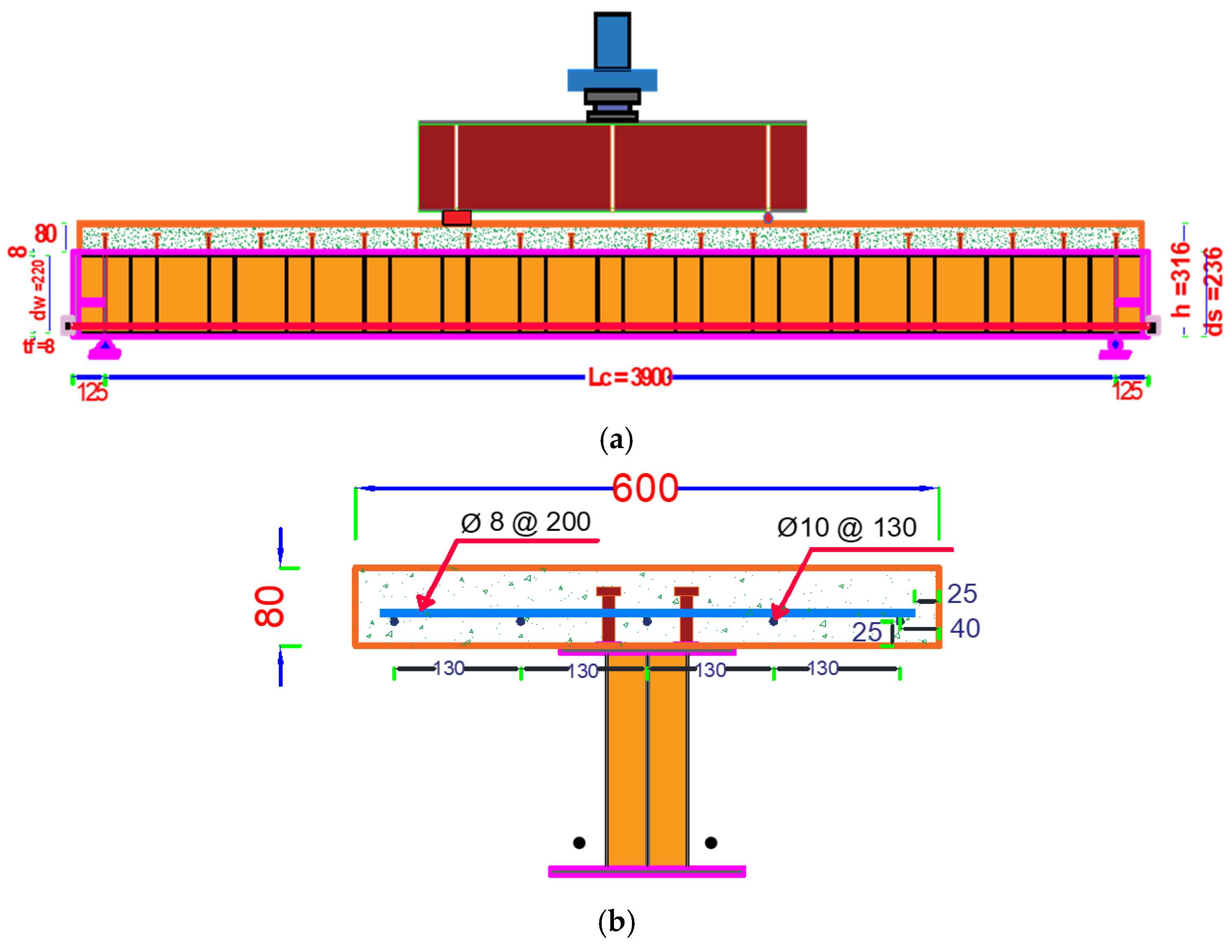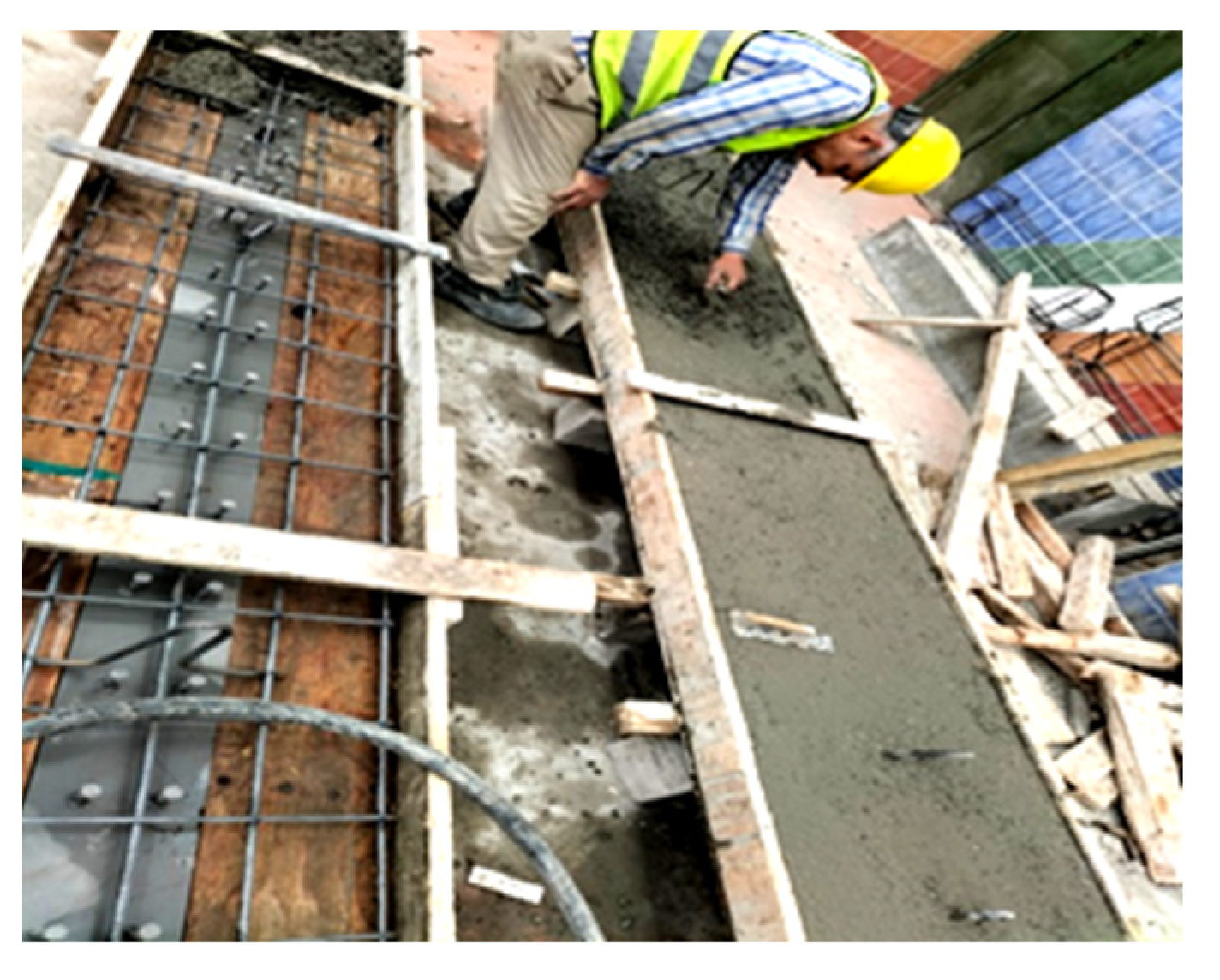1. Introduction
Steel-concrete composite beams present a popular and economical form of construction in both buildings and bridges. Advances in structural and fabrication technology have established the optimization of steel girders. The idea of using corrugated webs in steel structures to increase buckling resistance was first tried out as early as 1924, but due to difficulties in fabrication, its use was limited until further technical development [
1,
2]. As part of a national French project, a search for lighter and stronger girders took place, which could be achieved by external prestressing and corrugated web (CW). A large-scale test model was built by Campenon Bernard in 1983 and was externally prestressed. Afterwards, they built the first ever corrugated steel web bridge, Cognac Bridge, which was constructed in France between June 1985 and July 1986 [
2,
3]. Many advantages can be gained from using external prestressing [
4]. Prestressing can increase the beam capacity and reduce the serviceability deflection. It can also improve the behavior of the beam against fatigue and increase the elastic behavior zone. The first ever corrugated steel-built web bridge was the Cognac Bridge, constructed in France between June 1985 and July 1986 [
2,
3,
5]. The Maupre Bridge was the second bridge built with a corrugated steel web [
2].
It is well known in the literature that flat steel web (FW) is widely used for composite beams. For instance, Ayyub et al. [
4] tested three prestressed composite beams under a positive bending moment. They concluded that adding prestressing to beams could reduce the mid-span deflection and increase the elastic behavior regime and the ultimate load capacity. They also found that the use of the straight tendon profile with saddle points is more efficient than that of the draped tendon profile. Chen and Gu [
6,
7] studied prestressed composite beams under negative and positive moments and found that, in negative moment regions, the cracking resistance of the beams can increase, but the yield moment does not always increase. In contrast, positive moment regions showed a significant increase in yield and ultimate load. Lorenc and Kubica [
8] tested six simply supported prestressed and non-prestressed composite beams with straight and draped tendon profiles under the sagging moment. It was found that the tendon profile had no significant effect on the beam resistance. El-Zohairy and Salim [
9,
10] studied numerically the composite beams at sagging moment regions. The study found that the trapezoidal profile shape shows better behavior than the straight tendon, which shows more ductile behavior at the same level of eccentricity. Prestressing the beam using a full-length tendon can reduce the formation of fatigue cracks and a partial degree of composite action greater than 80% is recommended to obtain the desired performance in prestressing. El-Zohairy et al. [
11] developed FEM to simulate the behavior of continuous prestressed composite beams at hogging moment regions. The FEM was validated with existing laboratory tests. They found that the beam capacity increases by about 8% and the cracked moment redoubles. El-Zohairy et al. [
12] tested four composite beams to assess the effect of externally prestressed tendons on fatigue behavior and beam capacity. They found that the prestressed tendon could decrease the strain of the beam elements at all stages of loading, which leads to improved beam performance under fatigue. Da Rocha Almeida et al. [
13] tested two prestressed and non-prestressed composite beams with profiled steel decking under two points of loading. The test ended before its failure because of the excessive deformations of the models and safety fears. They developed FE models to simulate the behavior of the tested beam and found that the failure mechanism was the yielding of structural steel beams in tension, and that adding prestressing force to the beams can increase the maximum moment by up to 19%. A parametric analysis on an external prestressed composite beam was conducted by Da Rocha Almeida et al. [
14]. An analytical model using plastic moment analysis and a numerical FE model was used in this study after vitrification in previous tests. They found that the analytical model results are comparable with the FE model and the position of a shorter tendon in a pure moment region is less efficient than the full and moderate tendon length.
Comparing CW with FW, the CW has the following advantages [
2,
15,
16]; adequate out-of-plane stiffness, high in-plane shear force resistance with narrow-spaced folds, stiffeners elimination, less weigh and economical beams. Therefore, several case studies were proposed to accurately study the effect of the external prestressing on the different types of steel concrete composite I-beams. For example, five prestressed girders with a span of 5.5 m, fabricated with prestressed concrete bottom flanges, reinforced concrete top flanges, and zigzag corrugated steel webs, were tested on two points of load by [
17]. They concluded that no post-buckling will be shown when the web reaches shear yield strength. The tested girder showed high deflection recovery because of its ductility. Three full-scaled composite beams were tested by Kim and Lee [
18], who found that the steel beam with CW was able to introduce larger prestress into the top and bottom flanges, compared with the typical I-shaped steel beam, because of the accordion effect. Based on numerical analyses, Kim et al. [
19] used the concept of the effective moment of inertia (I
eff) and the effective sectional area (A
eff) to obtain the section stress and strain of a prestressed composite beam with CW. By using the coefficient of the effective moment of inertia (η
f) and the coefficient of effective web area (η
a), a very accurate estimation of the accordion effect and of flexural behavior can be achieved. They also found that the flexural strength and stiffness of the prestressed composite beams increased by about 20% to 25% compared with the non-prestressed. Lee et al. [
20] studied two new specimens to investigate the effect of the welding method and concluded that the use of partial welding can reduce time and cost and give the required performance, compared with gross welding. Xu, Zhang [
21] investigate the reliability of the ABAQUS finite element model that was used to simulate the external prestressed concrete composite beam with CW after its verification in the work of Song, Zhang [
22], who found that the consideration of secondary effects for externally prestressed tendons in the calculation is irrational. Motlagh and Rahai investigated numerically the long-term losses of prestressed composite beams with CW. Decreasing the corrugation depth could decrease the prestressing losses [
23]. The structural performance and cost-effectiveness of a composite beam with CSW for an extradosed cable-stayed bridge were investigated [
24]. Three different prestressed steel–concrete composite beams with corrugated web were investigated experimentally and numerically by Zhou et al. [
25] under fire conditions, the first beam without encased web, the second encased with concrete from one side, and the third encased on two sides. The failure of the first beam was the buckling of the web. The beam with one-sided concrete between the flanges experienced horizontal deflection, and shear centers move in the direction of the coldest side of the web. Numerical analyses showed that the failure appears to have been caused by cable strands rupturing inside of concrete enclosure.
An overview of the different contributions of different types of prestressed composite steel-concrete I-beams that have been investigated in the literature is presented in
Table 1.
In light of the previous discussion, ample research has been focused on the use of composite flat web beams and their behavior under external prestressing, but utilizing corrugated web in buildings and bridges has also increased in recent years. There is also an urgent need to strengthen these types of beams, which can be achieved by using external prestressing. A small amount of research has been conducted on the full and partially encased prestressed I-beam with CW, based on information available to the authors. Additionally, no studies have investigated the behavior of the externally prestressed steel I-beam with a single or double corrugated web. Therefore, the flexural behavior of externally prestressed composite steel-concrete I-beams with a single and double corrugated web was experimentally and numerically investigated in this paper. Three simply supported prestressed steel-concrete composite I-beams with single corrugated web (SCW) and double corrugated web (DCW) were tested under four-point loading. The tested beams were externally prestressed by using straight tendons along the full length. The ABAQUAS package was used to simulate the nonlinear behavior of the tested beams. The developed model was validated against experimental results to carry out a parametric study to investigate the effect of various parameters on the behavior of the composite beams with SCW and DCW.




























